The siege of Utrecht took place between June 23 and August 31, 1483 as part of the Hook and Cod wars and the Second Utrecht Civil War.
The siege of Utrecht took place between June 23 and August 31, 1483 as part of the Hook and Cod wars and the Second Utrecht Civil War.

The Burgundians had tried to control the Bishopric of Utrecht since 1456, when David of Burgundy had become the new Prince-Bishop. Supported by the Cods and opposed by the Hooks, this conflict was linked to the century-old Hook and Cod wars. When Charles the Bold unexpectedly died in 1477, opposition to David of Burgundy flared up again, culminating in the Second Utrecht Civil War (1481–1483).
David of Burgundy had to flee Utrecht and seek support from the new ruler of Burgundy, Maximilian of Austria.
Only back in control of the city of Utrecht since April 21, 1483, Prince-Bishop David of Burgundy was surprised in his old episcopal palace by a daring and stealthy night raid of the Hooks on May 8. The Prince-Bishop was captured and then imprisoned in Amersfoort. When Maximilian of Austria heard this news, he formed a large army under Joost de Lalaing to besiege Utrecht.
The Archduke Maximilian set camp before the walls of Utrecht on June 23 and laid siege to the city. His troops' bombardment of the city walls seriously undermined the city's defences and the Hooks quickly requested a truce. Viscount Jan of Montfoort, Engelbert of Cleves and Gerrit Zoudenbalch then left the city to negotiate terms with the Archduke. The Viscount was not prepared to accept Maximilian's terms without further consultations with his allies so Engelbert of Cleves and Gerrit Zoudenbalch remained behind as hostages whilst Viscount Jan returned to the city. Shortly thereafter the inconsidered action of a party of Maximilian's troops broke the truce and in reaction Jan of Montfoort's Hook militants re-commenced hostilities with their besiegers. As a result, both Engelbert of Cleves and Gerrit Zoudenbalch were now considered to be prisoners of war.
The resumption of hostilities led to a hand-to-hand struggle for Utrecht which became uglier by the day with both sides suffering severe losses. With the chief Hook personalities dispersed, discouraged or in captivity, the peace party in Utrecht once again gained the upper hand over the viscerally anti-Burgundian Viscount Jan. Maximilian, who had seen his stadtholder, Joost de Lalaing, and many of his men fall as casualties in the course of the siege, was now also inclined to peace. His conditions for capitulation were hard but not harsh and were readily accepted by the war-torn city.
Having taken control of Utrecht the Archduke continued on to Amersfoort, where he liberated David of Burgundy. For financial, political and economic reasons it was in the interest of both Maximilian and David of Burgundy to effect a lasting reconciliation with their adversaries, and their moderate post-war policies reflected this need.

Utrecht, officially the Province of Utrecht, is a province of the Netherlands. It is located in the centre of the country, bordering the Eemmeer in the north-east, the province of Gelderland in the east and south-east, the province of South Holland in the west and south-west and the province of North Holland in the north-west and north. The province of Utrecht has a population of 1,353,596 as of November 2019. With a land area of approximately 1,485 square kilometres (573 sq mi), it is the smallest province in the country. Apart from its eponymous capital, major cities and towns in the province are Amersfoort, Houten, IJsselstein, Nieuwegein, Veenendaal and Zeist. The busiest railway station in the Netherlands, Utrecht Centraal, is located in the province of Utrecht.

The Hook and Cod wars comprise a series of wars and battles in the County of Holland between 1350 and 1490. Most of these wars were fought over the title of count of Holland, but some have argued that the underlying reason was because of the power struggle of the bourgeois in the cities against the ruling nobility.
Engelbert of Cleves, Count of Nevers was the younger son of John I, Duke of Cleves and Elizabeth of Nevers, only surviving child of John II, Count of Nevers.

The Burgundian Circle was an Imperial Circle of the Holy Roman Empire created in 1512 and significantly enlarged in 1548. In addition to the Free County of Burgundy, the Burgundian Circle roughly covered the Low Countries, i.e., the areas now known as the Netherlands, Belgium and Luxembourg and adjacent parts in the French administrative region of Nord-Pas-de-Calais. For most of its history, its lands were coterminous with the holdings of the Spanish Habsburgs in the Empire.
The Battle of Westbroek was a battle that occurred on 26 December 1481 between the armies of the prince-bishopric of Utrecht and the county of Holland. It was one of the last battles of the Hook and Cod wars.
The Zoudenbalch family was one of the most prominent families of Utrecht throughout the Middle Ages to the age of the Dutch Revolt. They occupied all posts of importance in the city government, possessed various lordships in the vicinity and played a leading role in the history of the Sticht. The Zoudenbalchs were also Lords of the island of Urk in the Zuiderzee for over a century (1476–1614), and as such played a key role in the life of that community during troubled times in the 16th century.
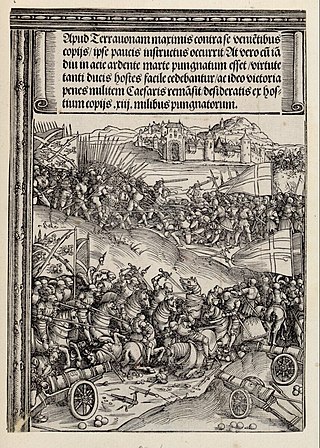
The First Battle of Guinegate took place on 7 August 1479. King Louis XI's French troops, led by Philippe de Crèvecœur d'Esquerdes, were defeated by the Burgundians, led by Archduke Maximilian of Habsburg. The battle was the first in which the innovative Swiss pike square formation was used by a power that was not natively Swiss.

David of Burgundy was the bishop of Utrecht from 1456. The illegitimate son of Philip the Good, Duke of Burgundy, David was made bishop by his father in an attempt to enforce more centralised Burgundian control over the Netherlands. He also served as bishop of Thérouanne from 1451 to 1456. He is the third longest-reigning bishop of Utrecht after Balderic and Willibrord, holding the see until his death in 1494.

The Burgundian inheritance in the Low Countries consisted of numerous fiefs held by the Dukes of Burgundy in modern-day Belgium, Netherlands, Luxembourg, and in parts of France and Germany. The Duke of Burgundy was originally a member of the House of Valois-Burgundy and later of the House of Habsburg. Given that the Dukes of Burgundy lost Burgundy proper to the Kingdom of France in 1477, and were never able to recover it, while retaining Charolais and the Free County of Burgundy, they moved their court to the Low Countries. The Burgundian Low Countries were ultimately expanded to include Seventeen Provinces under Charles V, Holy Roman Emperor. The Burgundian inheritance then passed to the Spanish branch of the Habsburgs under Philip II of Spain, whose rule was contested by the Dutch revolt, and fragmented into the Spanish Netherlands and the Dutch republic. Following the War of the Spanish succession, the Habsburg Netherlands passed to Austria and remained in Austrian hands until the French conquest of the late 18th century. The Bourbon Restoration did not re-establish the Burgundian states, with the former Burgundian territories remaining divided between France, the Netherlands and, following the Belgian Revolution, modern-day Belgium.
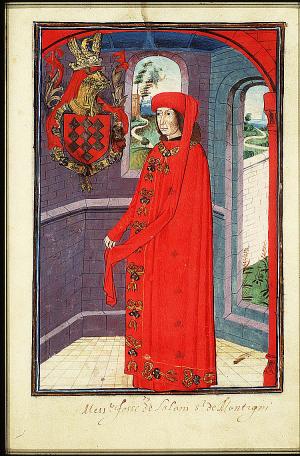
Joost de Lalaing, lord of Montigny and of Santes, was a noble from Hainaut who filled several important posts in service of the Burgundian Dukes.
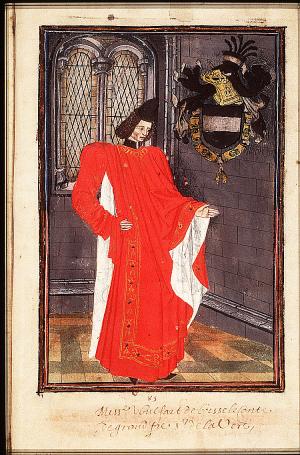
Wolfert VI of Borselen was stadtholder of Holland, Friesland, and Zeeland, Admiral of the Netherlands outside Flanders, and Lord of Veere.

Elizabeth of Nevers was Duchess of Cleves from 1455 until her death, due to her marriage with John I of Cleves-Mark. She acted as regent of the Ducky of Cleves during the absence of her spouse in 1477.
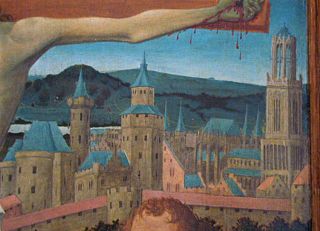
The Utrecht war of 1481–83 was a diocesan feud in the Prince-Bishopric of Utrecht between 1481 and 1483, influenced by the ongoing Hook and Cod wars in the neighbouring County of Holland. It was also a battle for control over Utrecht between the Dukes of Burgundy in the person of ruling Bishop David of Burgundy, and the Duchy of Cleves, which sought to replace him with Engelbert of Cleves.

Jan III van Montfoort, was Viscount of Montfoort, Free Lord of Zuid-Polsbroek, Free Lord of Purmerend-Purmerland, and a leader of the Hook Party in the Bishopric of Utrecht.

Philip of Cleves, Lord of Ravenstein, Wijnendale and Enghien, was a nobleman from the Low Countries and army commander, first for Maximilian of Austria, then for Flemish rebels and the kingdom of France.
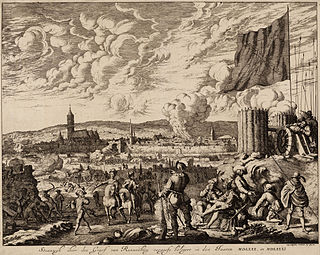
The siege of Steenwijk took place from October 18, 1580 – February 23, 1581 during the Eighty Years' War and the Anglo–Spanish War, between a besieging Spanish force under turncoat George van Lalaing against a Dutch rebel garrison at Steenwijk under Johan van den Kornput. An English and Dutch rebel force under John Norreys successfully relieved the town on January 24, and the Spanish in addition to ill-health and lack of supplies subsequently lifted the siege in February.

In the period 1482–1492, the cities of the County of Flanders revolted twice against Maximilian of Austria, who ruled the county as regent for his son, Philip the Handsome. Both revolts were ultimately unsuccessful.

The Utrecht Schism was a diocesan feud in the Prince-Bishopric of Utrecht from 1423 to 1449. The legitimate prince-bishop of Utrecht was at issue. The war of succession was fought by Zweder van Culemborg and his brother Walraven van Meurs against Rudolf van Diepholt. The conflict mixed with the existing Utrecht factionalism between the Lichtenbergers and Lokhorsten and with the Hook and Cod wars raging in the County of Holland. Some scholars consider the Utrecht Schism to have ended in 1429.
The Siege of Gouda (1428) was a siege that ended the second phase of the Hook and Cod wars.